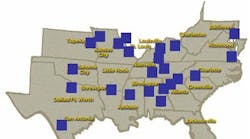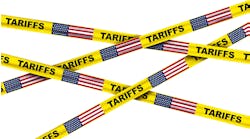Geographic Patterns And Trends In The Automotive Industry
Editor's Note: This is the second part of a two-part article. The first article was The Automotive Industry: Economic Impact and Locations Issues.
Non-U.S. companies dominate the plants in the South. In the 1980s, transplants were built in the 1-75/I-65 corridor, within a 1-day drive of Detroit. In 1990s, new transplants were built in the Deep South. Parts plants followed the trend. However, there are definite patterns in geographic location: the heavier the part, the more it tends to be manufactured near Detroit. The South mostly gets more portable parts such as electrical, drivetrain and fluid handling.
Transplants spread from Kentucky to Alabama and points west:
Major Auto Assembly Plants In The SouthSource: Southernautocorridor.com
However, employment growth in the industry is expected to be concentrated in part manufacturing, rather than in auto and truck assembly. The last two are expected to shrink somewhat as some companies downsize operations and trim personnel to increase productivity nationwide.
Employment Forecasts
NAICS (North American Industrial Classification System) Legend:33611: Automobile and Light Duty Motor Vehicle Manufacturing 33612: Heavy Duty Truck Manufacturing33621: Motor Vehicle Body and Trailer Manufacturing33631: Motor Vehicle Gasoline Engine and Engine Parts Manufacturing33632: Motor Vehicle Electrical and Electronic Equipment Manufacturing 33633: Motor Vehicle Steering and Suspension Component (except Spring) Manufacturing33634: Motor Vehicle Brake System Manufacturing33635: Motor Vehicle Transmission and Power Train Parts Manufacturing33636: Motor Vehicle Seating and Interior Trim Manufacturing33637: Motor Vehicle Metal Stamping33639: Other Motor Vehicle Parts ManufacturingSource: CHLG Input-Output Model
Wages, productivity and potential profitability are among the major regional factors that manufacturers consider in their location decisions. A regional wage index is defined as average wage in the region divided by the U.S. average wage. In the automotive industries, the South has a Wage Index of 0.9 compared with 1.05 in the Midwest and Northeast. The difference is larger in auto assembly operations.
In terms of productivity, the news is not as good. Forecasted increases in productivity (of 20%) are the same across the country in the 2006-2011 period. The implications are important: the South has no big advantage in productivity and employment will be falling as the same people will be able to produce 20% more. In the long term, attracting more automotive business through a combination of competitive costs, higher quality workers and productivity enhancing actions (such as infrastructure initiatives) will keep automotive employment from shrinking.
Customization And Energy Shocks
The auto industry went from high-cost, hand-made custom work to mass production between the two world wars. We are now in an era of mass customization. There is dramatic market fragmentation, which means that automakers have to produce a large variety of models and have rapid model turnover.
This creates a dilemma between the efficiency of mass production and the complex needs of customers. To bridge the two, Toyota pioneered lean manufacturing techniques, which have been adopted by other companies to a greater or lesser extent. However, a cynic might counter that lean assembly, just-in-time and low goods-in-process inventories are all very well, but finished vehicles are still produced for inventory. Typically, 45 to 60 days of inventory is piled up on parking lots, dealerships and in transit. The costs are staggering: billions of dollars in working capital are tied up, while companies run the risk of changing tastes and circumstances, such as gasoline price spikes, which may dramatically alter the demand for vehicles away from forecasts and production. It that case, discounts are needed to "move the metal," and customers have become addicted to them. The lack of flexibility under union agreements amplifies these dilemmas for the Big 3.
The question then arises: why can't GM, Ford, Toyota and the rest of the large-volume automotive companies be like, say, Dell? Why can't they build every car only when there is a firm custom order for it?
Despite some efforts, the industry is still a very long way from building to order. There are many reasons for this. Customers don't want to wait (except for luxury cars), and often even enjoy haggling. The latter is especially true in the U.S., where people will buy what's available on the lot if they can get the price low enough. Corporate systems are slow at taking, consolidating, and transmitting orders. An extensive system of dealerships is well entrenched and protected by state and federal laws. Finally, manufacturing really is not flexible enough yet.
The second trend that is worth mentioning is the effect of high and volatile energy prices. These are renewing interest in technology development. Relevant technologies include:
- Alternative fossil-based fuels (gas-to-liquids, coal-to-liquids, hydrogen)
- Alternative bio-based fuels (ethanol, biodiesel)
- Alternative vehicle powertrains (hybrids, plug-ins, fuel cells)
The recent spike in fuel prices precipitated a drop in the sales of large pickup trucks and large SUVs that were providing the bulk of the profits for domestic automakers. In a replay of the 1970s oil crisis, the Big 3 were caught by surprise and their limited production flexibility has hurt their profitability.
The Automotive Company Of The Future: Implications For Economic Development
To paraphrase Mark Twain, predicting anything, especially about the future, is a risky business. Still, chronically low profitability is not something that can persist forever, and fundamental consumer and economic trends take a long time to change. It therefore seems safe to speculate that the auto company of the future will need better margins and a large variety of vehicles with a faster turnover of models. Better margins will require more efficient production and logistics with lower inventories of finished vehicles and more emphasis on vehicle life-cycle services, such as leasing and after-sales service. Profitability problems and competitive pressures will likely result in more consolidation of production and parts companies. Efficiency and mass customization will require more R&D, more niche and concept vehicles, and more vehicles built to order.
The implications for manufacturers follow logically, and include:
- Faster product design
- More flexible plants
- More commonality of parts and subassemblies
- But not so much as to affect look, feel, fit and finish
- Streamlined marketing, order-taking, assembly and delivery
- More outsourcing of manufacturing activities
- But stricter quality control
- More control on after-sales service
- More leasing
For auto parts manufacturers, all this means:
- More cost pressures
- More pressures for:
- Speed
- Flexibility
- R&D
- Quality control
- State-of-the-art logistics
- More consolidation
There are clear implications for site selection and economic development. The automotive industry in the U.S. obviously will not go away: it is too big a market for that. However, the players and types of facilities will change. The trend of foreign assemblers and suppliers locating here will continue, but will probably slow down. The South will continue to get most new plants for a while because of its advantages in cost, flexibility and demographics.
However, the South should not be complacent. Its future as a growing automotive region is not necessarily assured forever. The two most important issues that come out of our discussions with potential industrial employers are:
- Is the South ready to provide the educated workers, entrepreneurs, and inventors needed to get to the next level? A low-paid, hard-working workforce is clearly no longer enough.
- Will it have the physical infrastructure for the ongoing logistics revolution?
On these questions hinges the future of the automotive industry in the South. Both will require money and effort to address. Both are at odds with the South's attractions as a low-tax region. But if it were easy, every community would be successful all the time.
Yorgo Papatheodorou is a senior project manager with CHSM HILL's business location and economic development consulting group. For several years he has served as a director of the National Association for Business Economics (NABE) and as chair of NABE's Manufacturing Roundtable.
Michelle Harris is a Project Consultant, P.E. (Professional Engineer) for CH2M HILL. She worked with the CH2M HILL team to develop a proprietary target industry analysis model and the very popular target company predictive model.
CH2M HILL is a global firm providing engineering, construction, operations, consulting and related technical services to public and private clients. The firm's work is concentrated in the areas of manufacturing, chemicals, pharmaceuticals & biotech, electronics, energy, power, communications, transportation, water and environment. www.ch2m.com




